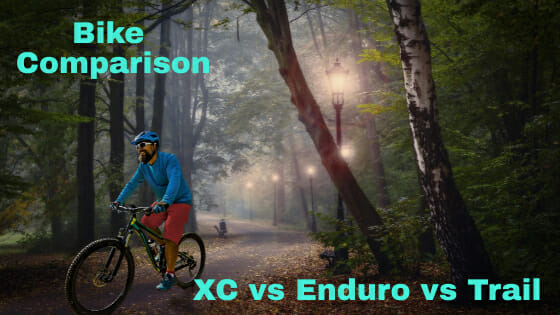Cross country (XC), enduro, and trail are three popular types of bikes. It’s hard to choose between these mountain bikes. There’s a lot to consider, including what size wheels to go for and the geometry.
So I’ve come up three most popular types of XC vs Enduro vs Trail bikes. Let’s sift through all the options and make a decision that suits your riding style.
Comparison Table of XC Vs Enduro Vs Trail Bikes
| Traits | XC | Enduro | Trail |
| Geometry | 67.5 ° | 66° | 64-66° |
| Bottom Bracket Height | 340 mm | 345 mm | 347 mm |
| Suspension Travel | 100-120 mm | 140-160 mm | 120-140 mm |
| Tires size | 1.9-2.5 inch wide | 2.25-2.4 5-inch wide | 2.25-2.4 5-inch wide |
XC vs Enduro vs Trail Bikes: In-Depth Differences
Each bike is designed to best suit a particular trail type frames are shaped to put the rider in the best position. For those trails, wheels and other components are added to the bike based on the advantages.
They provide within the style of riding the trails dictate there is an overall, of courses you’re not locked into a single style of riding. The bike is designed for you can take each out of its comfort zone to a significant degree.
However, along with its advantages, each bike has its limitations. So it’s best to be informed before purchasing the bikes and the trails you’re most likely to ride.
- XC Or Cross Country
Traditionally, cross country races are mass start events on long arduous courses that test the riders’ endurance, bike handling, and skill. Recreationally, however, cross-country riding can simply mean long meandering journeys on non-technical tracks or even fire rates.
Advantage
- Cross-country bikes are tailored for smoother, longer trails and built to be light and efficient.
- A shorter wheelbase, shorter reach, and a steeper seat tube angle puts the rider in a position to push more power down other pedals.
- The shorter wheelbase combined with the steep head angle also adds to the bike’s handling capabilities.
- Frames are built with weight in mind, so lighter materials are favored, and riders can often but not always do away with dropper posts to save some grains.
If you come from a road cycling background, you’ll know that roadies are obsessed with stiffness in a bike. Because it’s more efficient, the stiffer a frame is, the more power from your pedal stroke converts to horizontal movement.
Disadvantage
- With the addition of a rear shock, both ends of the bike are shorter to maintain the spirit of efficiency.
- Providing between 100 and 120 mm of travel onto the wheels, and more often than not these days, you’ll find 29-inch wheels.
This is in service with a more speed, less energy approach, but 29 carries momentum better than smaller options tires will generally have less tread minimizing rolling resistance. But still, have enough grip for single-track riding.
- Enduro
On the other end of the spectrum, we have enduro bikes, where cross-country bikes are designed with ascending in mind. It’s descending as the primary consideration for enduro bikes like XC racing. Enduro racing happens on long, arduous courses.
Advantage
- The wheelbase is more prolonged, providing a more stable platform.
- Enduro bikes are tailored to be ridable uphill and extremely capable downhill.
- Geometry on an enduro is designed around speedy downhill stability compared to a cross-country frame.
- The head angle is much slacker, aiding downhill handling and speed, and the reach is more extended, putting the rider in a more aggressive position.
- Dropper posts are essential on enduro bikes. They enable the rider to pedal uphill in a seated position and shift their weight around on a descent without worrying about the seat getting in the way.
- The suspension is substantial for gnarly descents with 140 to 160 mm of travel.
- Standard on the front and similar numbers at the rear, tires have much more tread and width for better grip.
Disadvantage
- Through corners and over obstacles, wheels were traditionally 27.5 inches in diameter, but 29 is becoming more popular.
- 29 ers provide more traction, excellent roll-over ability on technical obstacles, and a smoother ride due to the increased air volume.
- 27.5-inch wheels, on the other hand, are more agile, typically more robust, and can be paired with more extended travel.
The jury’s still out on which size is better with the baits still vital in the mountain bike community.
- Trail Bikes
A trail bike sits between a cross-country and an enduro bike. They’re designed to be versatile, perfectly balancing both climbing and descending.
Advantage
- Trail bikes will be pretty capable of descending dual suspension is common on trial bikes but travels between 120 and 140 mm.
- Downhill handling is improved at the fork and the frame by a dropper seat post, a relatively slack head angle, a short stem, and wide bars onto wheels.
Disadvantage
- They’re not the perfect tool for either the geometry reflects.
- It’s worth noting that some trail bikes fly the geometry saving. The endura end of the spectrum, while others may lean towards the cross-country side, in the end, it comes down to the manufacturer.
- Their versatility is not quite as steep as an XC bike, not quite as slack as an enduring.
Which One To Choose Between These Three?
So, which one do you want to buy? Before purchasing your favorite bike, the first and most important consideration is the type of trails you want to ride.
This would dictate the style of riding your Leica to do and, therefore, the kind of bike that best suits that purpose if you can rack up the case and elevation on fire roads, bold single track, and less technical trails, and I recommend a cross-country bike.
If you’re looking at hitting the corners, dropping berms and jumps, and getting excited on descents, then an enduro bike is probably what you’re after. However, if it’s the flexibility and versatility to take your bike pretty much anyway, then it’s hard to beat a trail bike.
FAQs
Can you use an XC bike for trail riding?
An XC bike won’t have the suspension for rough or technical terrain, so you need a fundamentally trail-worthy fork. XC forks are primarily optimized for steep climbs and hard cornering and have many fasteners, and do without adjustable travel.
How do you turn a mountain bike into a trail bike?
If you want a mountain bike to tackle technical terrain, pick one with a suspension fork, and swap out the 27.5 x 2.6-inch tires for more capable 29 x 2.8-inch tires with lower pressure and less tread. You’ll also need additional components, like fender bosses, rack mounts, and possibly a tiny luggage mount.
Is 100mm travel enough?
Most trail riders use 120mm-travel forks, but 100mm will get you up to speed on technical terrain and is acceptable for most trails.
Conclusion
So we hope this article has given you a better understanding of the three types of mountain bikes XC vs Enduro vs Trail Bikes. Hopefully, you are better equipped to choose the one that suits your needs and uses. So go out there, enjoy the ride, and always wear your helmet.

I am Ryan Ford, a mountain biking enthusiast who loves to explore the outdoors. I also like to go on adventures with friends and anything else that involves being outside. I love my bike because it gets me out of the house and gives me an opportunity to enjoy nature.

